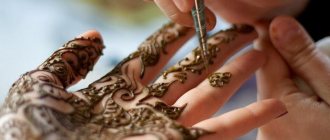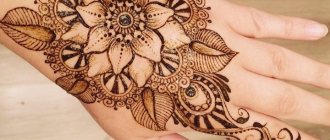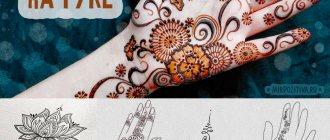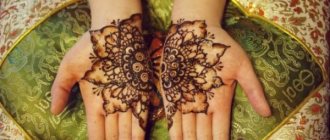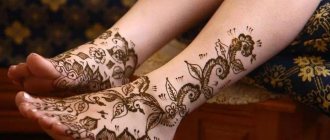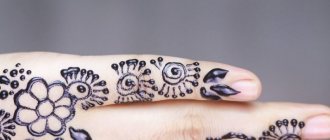What is mehendi? Deciphering the most popular mehendi symbols. How to do mehendi at home? Sketches and stencils of mehendi on hands and feet?
- Mehendi is the painting of the body with the help of a special henna. The henna used for mehendi drawings has nothing in common with the usual henna that our women dye their hair with.
- In order to paint the body, one needs to buy the special henna that can color the skin for a long time
- It is sold either as a ready-made tube, which you only need to open and start painting with it, or in bags as a dry powder, which must still be properly diluted
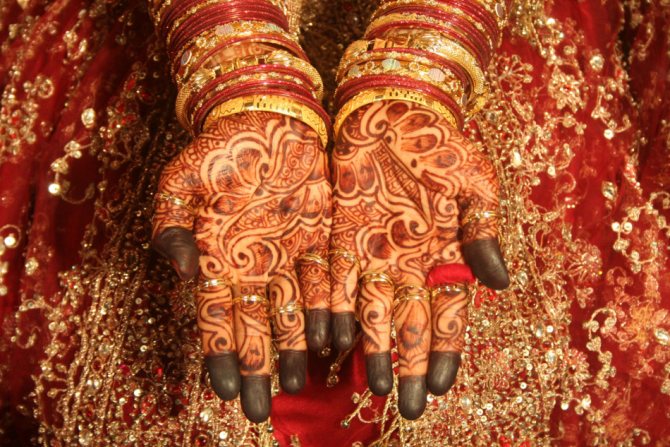
Mehendi
- Mehendi is suitable for those people who like tattoos, but they don't dare to make this decisive step. The fact is that the mehendi drawing is not eternal - it lasts only from two weeks to a month. Because the hesitant fans of permanent tattoos can wear mehendi for a while, and understand if they want to live their whole life with this image on their body.
- Often, mehendi drawings are used to decorate the palms and hands, as well as the feet and the upper part of the legs
- The mehendi drawings are made in different styles and have different semantic meaning.
Meaning of the symbols in mehendi drawings: photos with captions
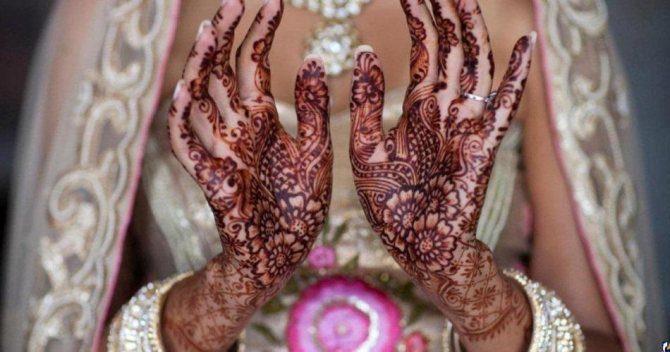

Meaning of the symbols in mehendi drawings
- There are four main styles of mehendi drawings. The difference between them lies in the places where they are distributed
- The fact is that in the Middle East it is more common to draw floral motifs. Such drawings are somewhat reminiscent of Arabic embroidery. Their performance is more spontaneous and never follows any sketches or templates.
- North African mehendi, as a rule, are drawn in the form of geometric figures with floral motifs. Such drawings must necessarily repeat the shape of the body on which they are performed
- Pakistani and Indian artisans do not stop only at the palms and feet of people acting as canvases. They stretch the patterns much higher, thus creating a kind of stockings or gloves woven from their patterns. Indian-Pakistani mehendi combine drop designs, ornaments and flowing lines
- Indonesian and South Asian mehendi have absorbed something of the ornaments of the Middle East and India
Here are some of the meanings of mehendi drawings:
Bracelet - the key to success in love affairs
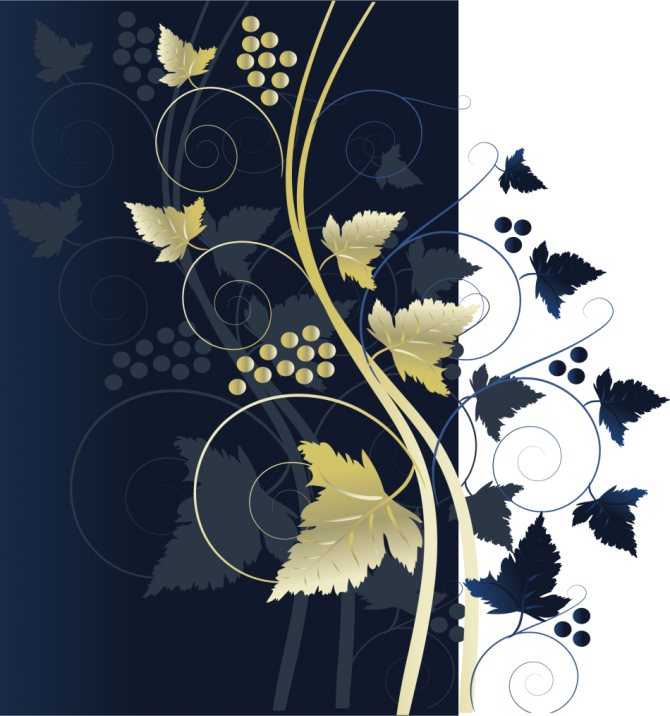

Grapevine - loyalty and devotion
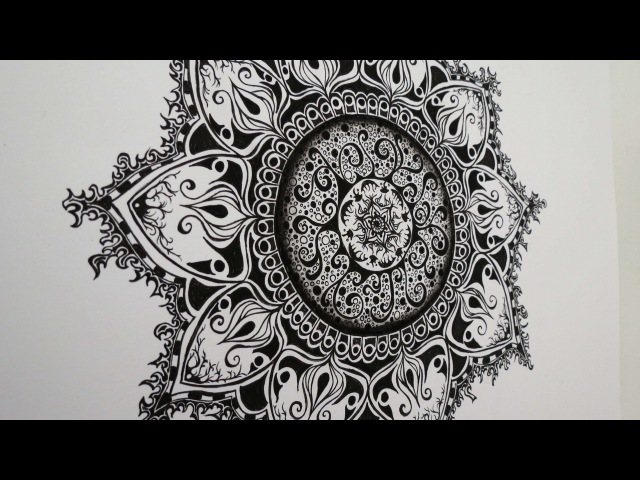

The octagon provides protection of a person from all four sides of the world, including from mixed directions The disk in the representatives of the stronger sex - domination over others, a sign of masculinity
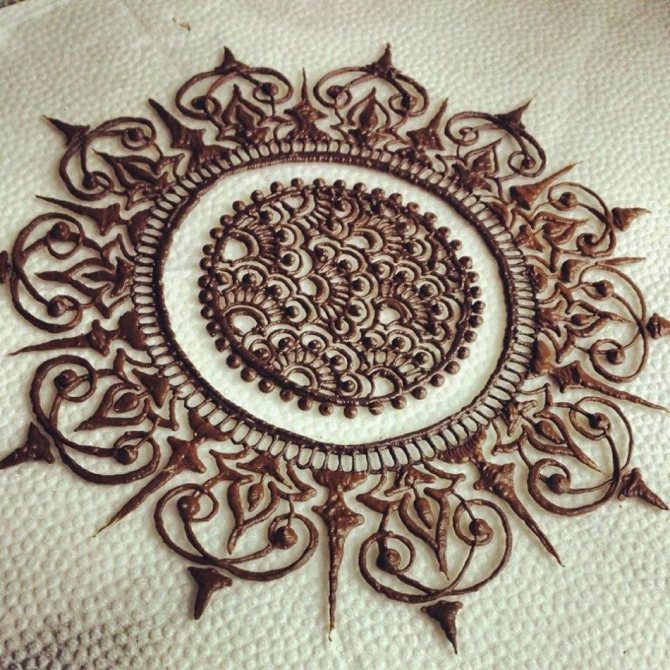

The disk in the fair sex is a symbol of chastity.


Five-pointed star - symbol of five elements Six-pointed star - harmony between a man and a woman


The star symbolizes divinity and hope.


Grain - symbol of plenty
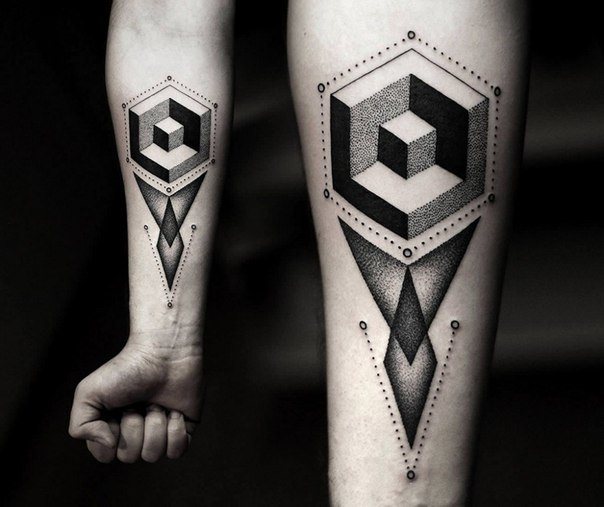

Square - symbol of honesty and constancy
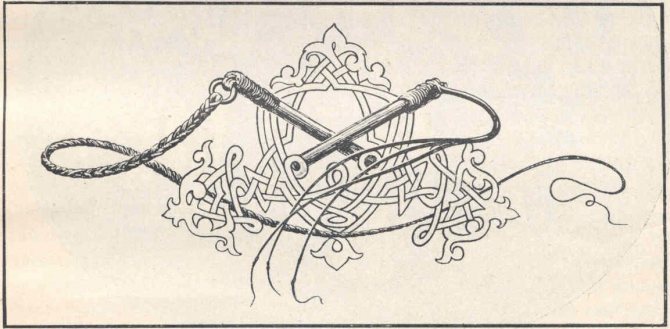

The whip symbolizes self-confidence and serenity.
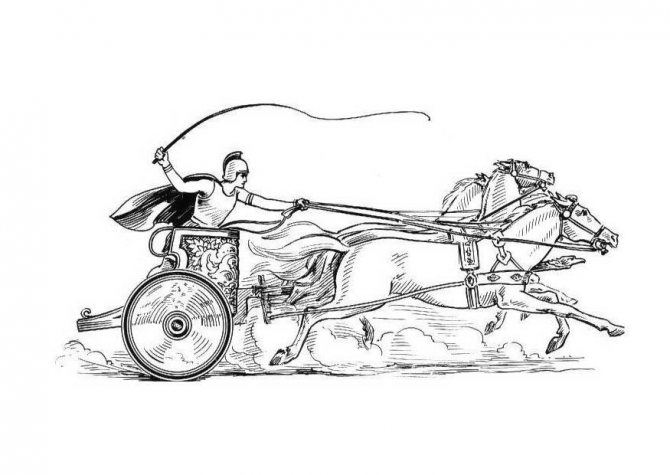

Chariot - great knowledge and good mental development


Cross - connecting link between heaven and earth Circle - one coil of life
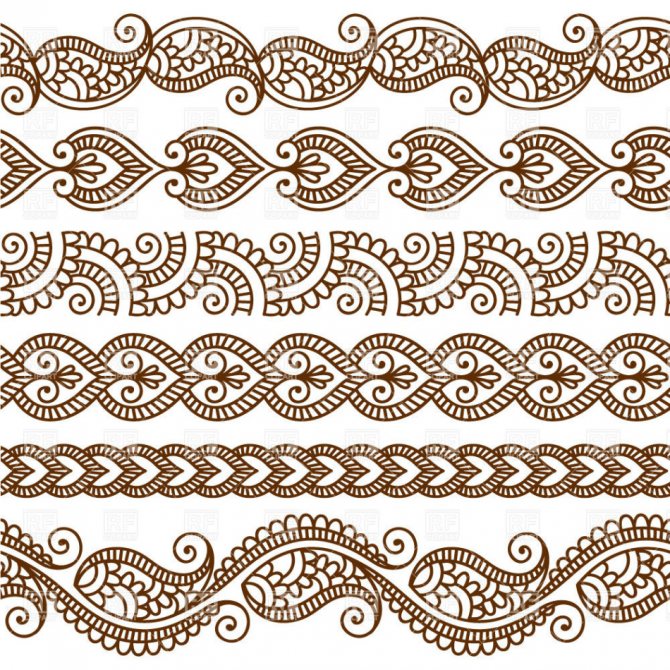

Curve - good luck, overcoming obstacles, career advancement Swan - success
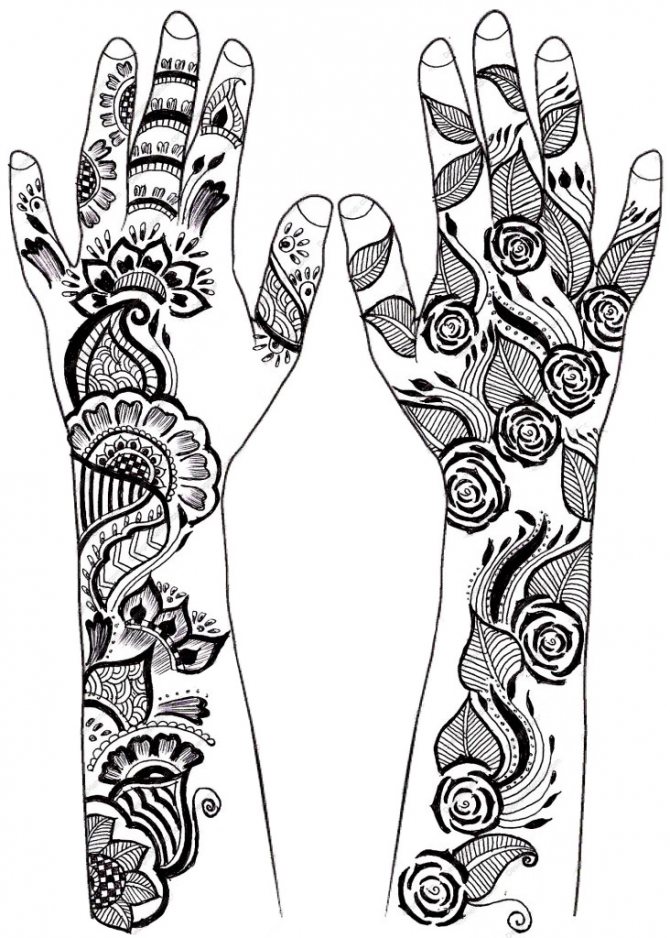

Liana - determination, helping to achieve success
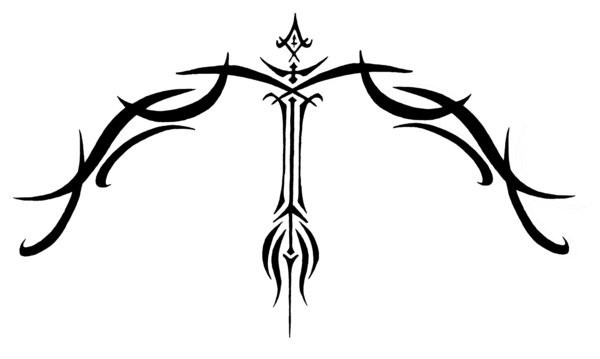

Bow and arrow - happiness in personal life, overcoming difficulties
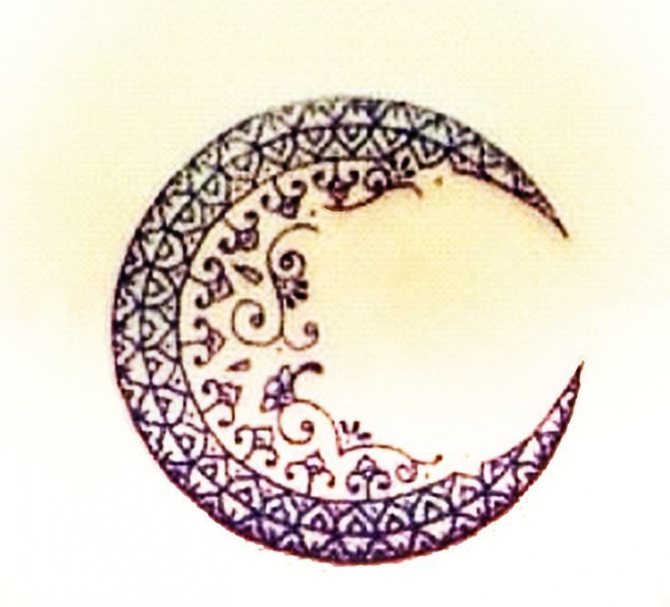

Crescent Moon - stunning beauty
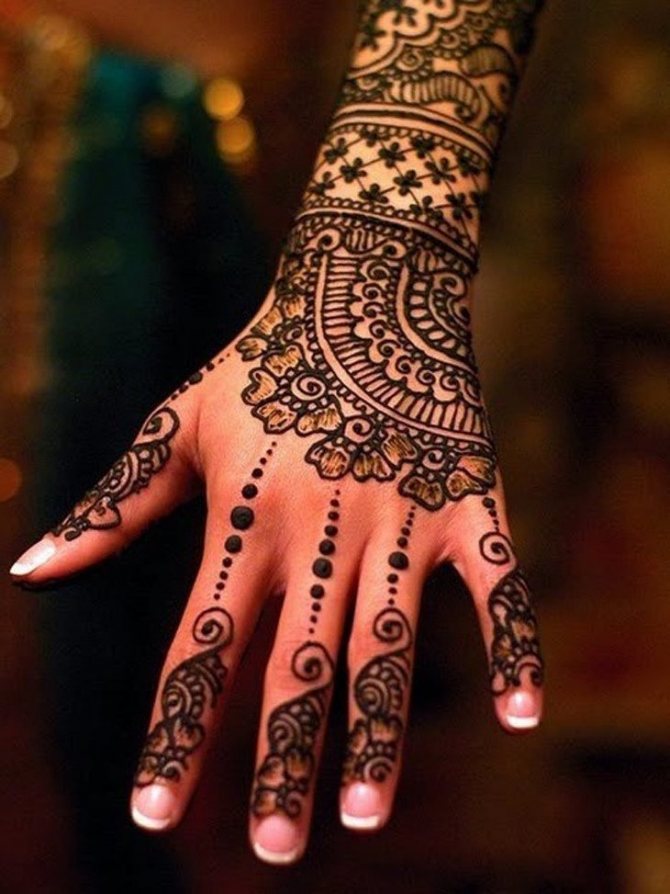

Little dots - a sign of love experienced by a woman to her spouse
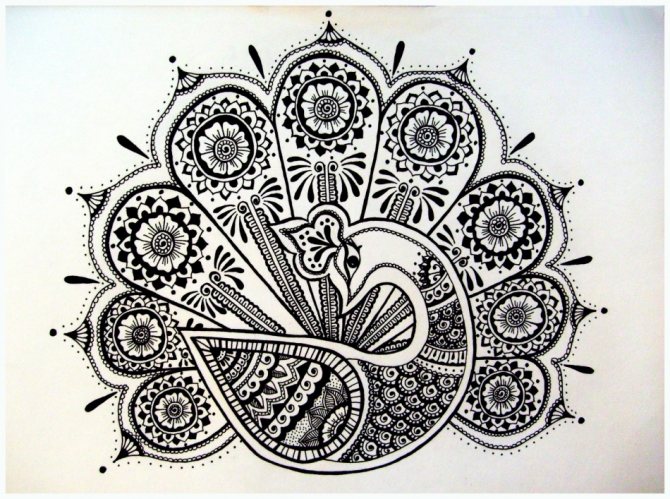

Peacock - passion, love, desire Parrot - herald Shell - amulet against all odds, a symbol of victory
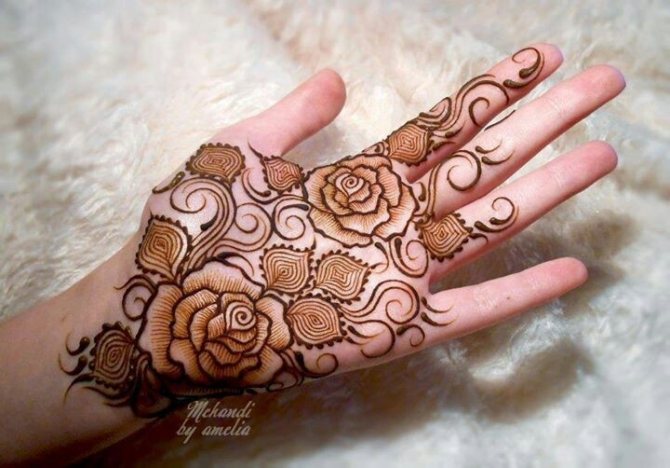

Rose - symbol of chastity
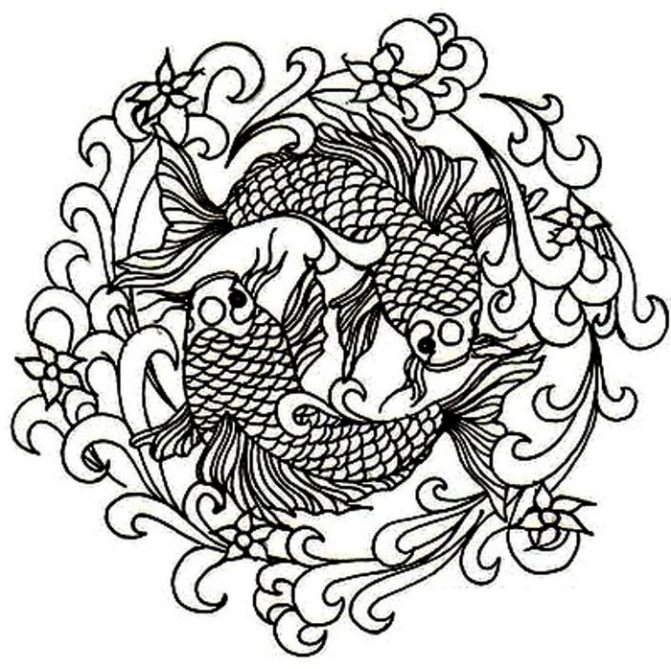

Fish - passion
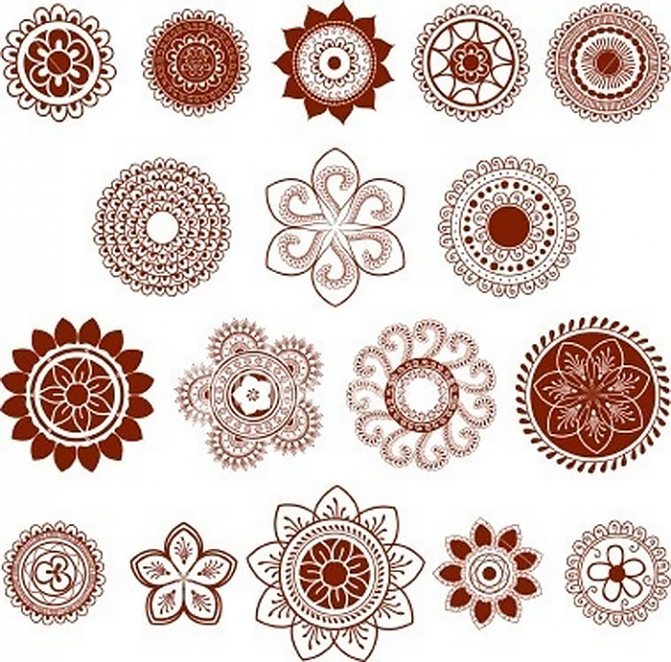

Sun - gate into the world of knowledge and eternal life Trident for men - courage, bravery and heroism, Trident for women - maternal origin, feminine inner strength and energy
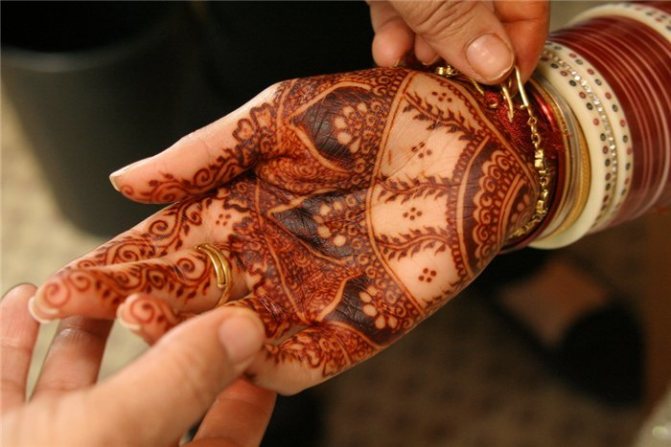

Triangle - totem from natural disasters, diseases and worries
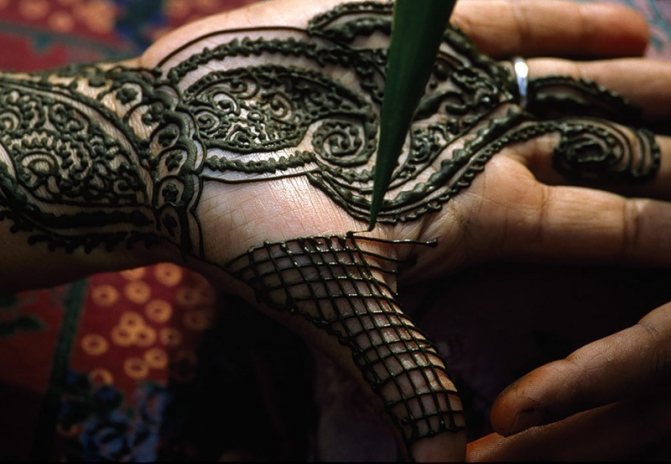

Flag - symbol of well-being and home
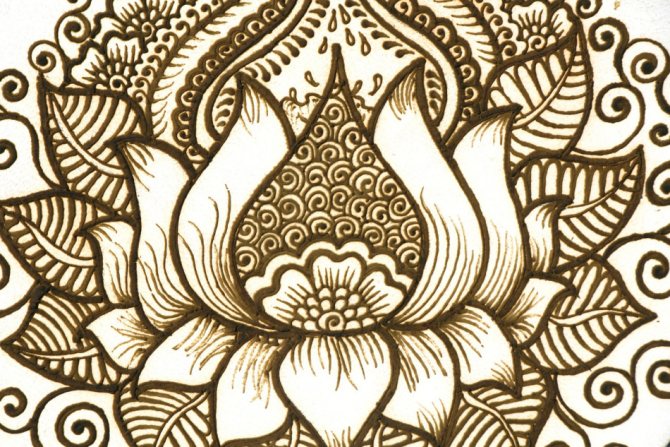

Lotus - good luck charm
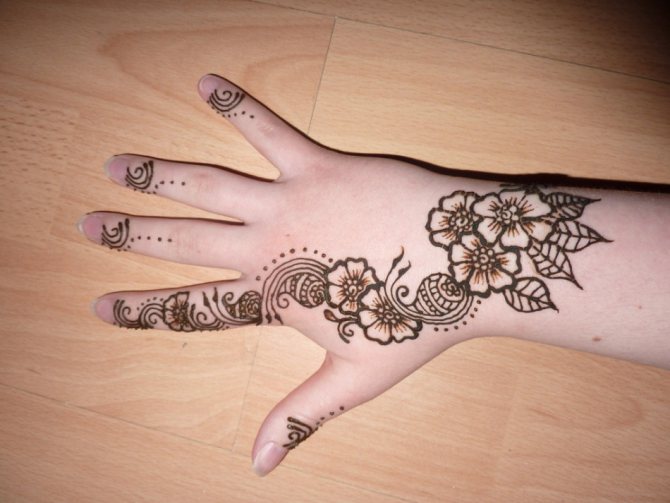

Flowers - new life
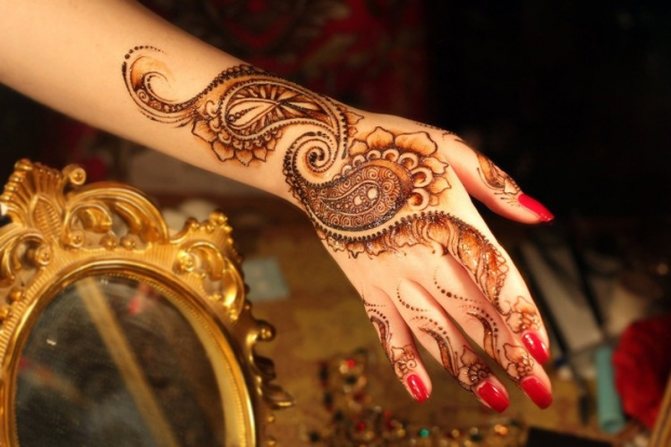

Cucumber - sign of development, energy, happiness, prosperity and immortality
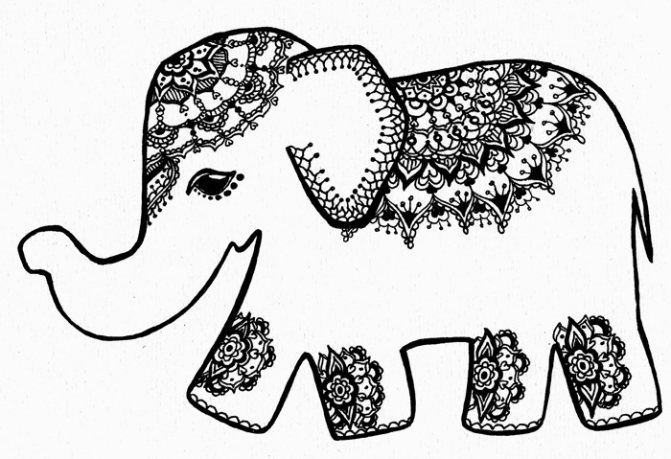

Elephant - strength, power, dominance, intelligence, dignity, fertility, immortality, happiness, and comprehensive goodness
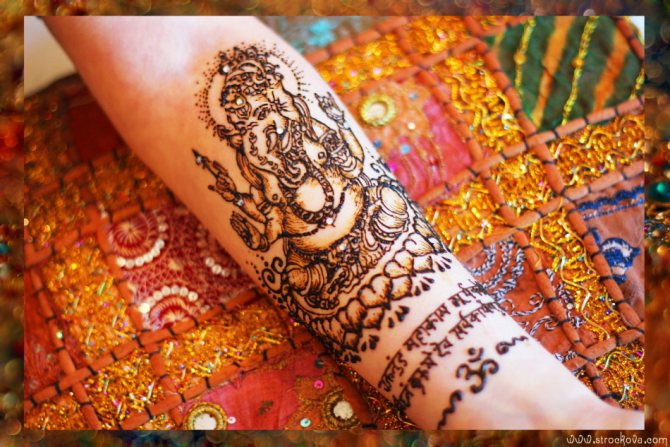

Sri Ganesha a symbol of wisdom, kindness and prosperity
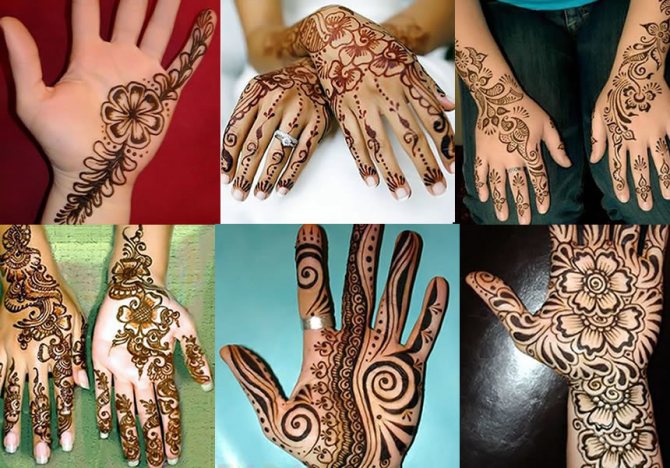

Spiral - symbol of self-knowledge
Goods for painting
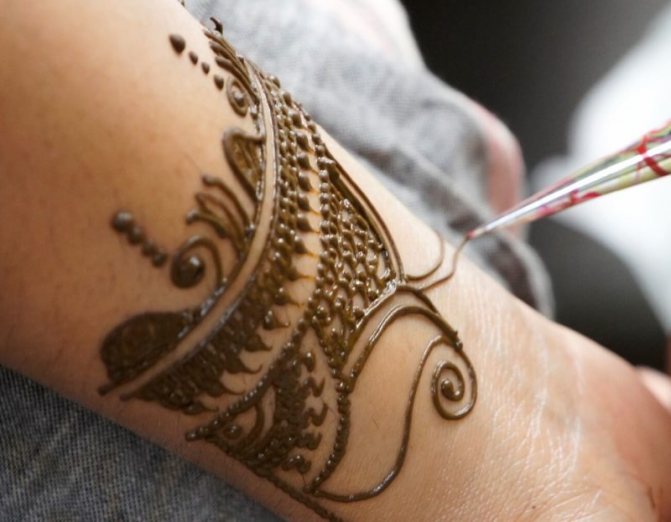

The main commodity for mehendi is henna, so let's give a couple of tips on how to choose a natural dye.
- There is no natural green or red henna. If you are offered to buy colored henna, it means that dyes, preservatives and other chemicals have been used in the production. You can draw with such a product, but the risk of an allergic reaction in this case increases significantly;
- The shelf life of a natural product for painting does not exceed 12 months, and after 3 gradually begin to lose the coloring properties. The "fresher" the paste, the brighter the drawing will be;
- packaging. Examine the henna cone, touch it. Try to put pressure on it. Good quality and timing henna will not let you squeeze and bend the cone.
Golecha


The paste in cones of this manufacturer is available in all specialty stores. In addition to natural brown henna, the brand offers colored - burgundy, black and green.
The price for 1 tube ranges from 50 to 180 rubles, depending on the seller.
Mehendi oil is also available from the same company. It contains clove and eucalyptus oil. The oil volume is 6 ml.
Price 100 - 150 rubles.
Kaveri .
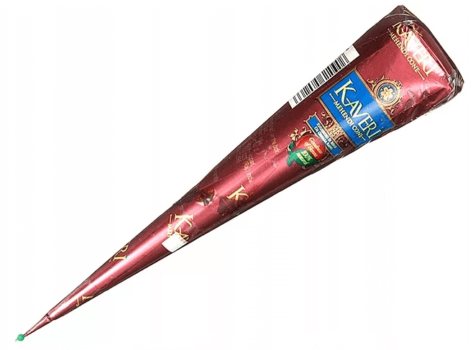

This brand is often used in beauty salons, as it has an all-natural composition. Because of its all-natural origin, the manufacturer recommends an allergy test at least 48 hours before painting.
The price per cone is 50 -200 rubles.
Some stores offer a set of 12 Kaveri cones. The price for a set is 190-300 rubles.
Sahara Tarazine
This manufacturer has already been mentioned when talking about cooking at home. Sahara Tarazine brand powder costs from 450 rubles per 100 grams.
Stencils
There are no branded stencils on sale - each store offers its own sets without specifying the manufacturer. The price for 1 stencil is 50-70 rubles. For example, in the store Mehendi-shop a palm stencil costs 70 rubles. And a set of 3 - 190.
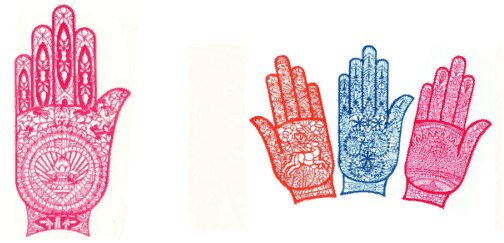

It is possible to use stencils for temporary tattoos, though they are not quite classical oriental or Arabian, for example Irisk offers a lot of floral ornaments.
For a stencil choice you can refer to Aliexpress - there are a lot of options.
Nikhar
The manufacturer offers an oil for mehendi. It is used to moisturize during wear and immediately after removal of the henna to fix the mehendi.
6 ml. - 100 rub.
How to draw mehendi on the arm step by step?
How to draw mehendi on hands step by step?
As mentioned above, it is better to buy mehendi hendi henna in special bags ready to use. This will be a hundred percent guarantee of a saturated color and duration of the effect. In addition, you can apply such a henna directly from the package by simply cutting off the tip.
If you still decided to prepare a paste of henna yourself, you need to know a few rules:
- It is better to buy henna in hermetically sealed packages, because henna on the loose loses its coloring ability due to constant contact with the air
- henna for hair dyeing is not suitable for dyeing skin
- It is better to buy natural henna - synthetic henna can cause allergies
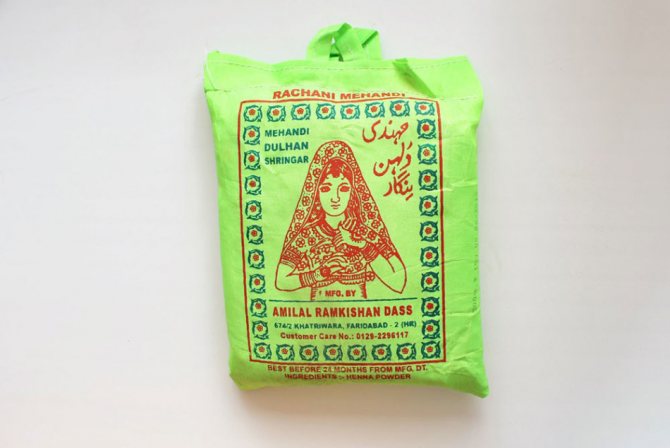

Preparation of henna for mehendi
The process of making a henna paste for mehendi:
- Make a strong black tea (three teaspoons of tea for half a liter of water).
- Boil the tea over low heat for five to ten minutes.
- Strain the tea.
- We gradually pour the infused tea into forty grams of henna, stirring continuously the resulting mixture.
- Add two tablespoons of lemon juice and a few drops of eucalyptus oil or mehendi oil to the henna mixture.
- The resulting mixture of the consistency of toothpaste should be placed in the refrigerator for four hours
- In an airtight package, the paste is stored for up to three weeks, and in frozen form - up to four months
To make a paste of henna, you can use simpler ways: mix tea and lemon juice in a ratio of one to one and add to them henna. Coffee can be used instead of tea. Some mehendi masters add sugar to the paste to increase its viscosity.
In general, it must be said that each master has his own recipe for making mehendi paste. Many of the makers of mehendi keep the finer points of preparing their steady henna solution a closely guarded secret.
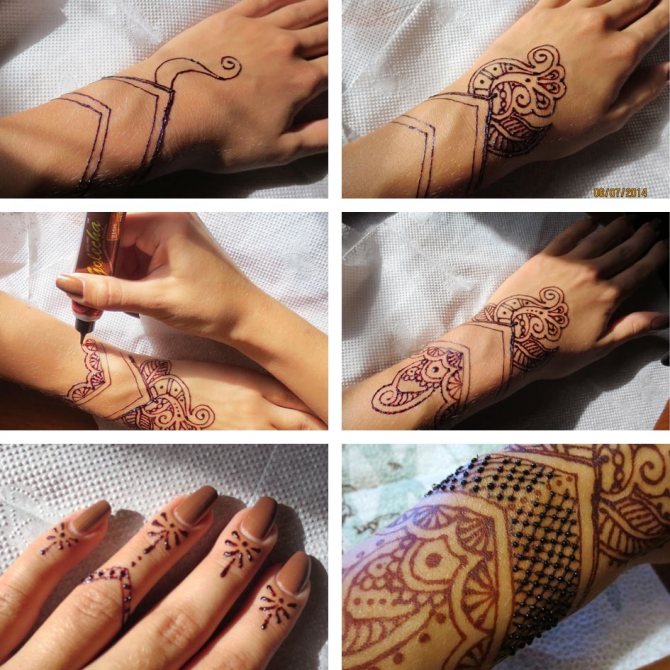

Application of henna on the skin
Mehendi drawing step by step on your hand:
- Before drawing, we conduct a skin sensitivity test to the henna solution. To do this, apply a small amount of paste on the inside of the elbow and wait for half an hour. If the test showed no reaction of the skin to henna, start preparing the skin area on which directly will be performed drawing
- Wash skin thoroughly with soap and water, you can even use a scrub for this purpose
- Remove excess vegetation from the desired area of the skin
- Before drawing, oil the skin with eucalyptus oil or special mehendi oil.
- Start with applying the pattern with large base lines, and then complete the pattern with small elements.
- You can apply mehendi directly from the bag, or you can do it with special brushes or sticks.
- The layer of paste, applied to the skin, should not be less than two millimeters
- If you make any mistake during the drawing process, remove it with a cotton swab
- After completing the drawing leave the henna on the skin for one hour
- At the end of this time with the blunt side of the knife or a special scraper remove the dry paste from the skin
- The mehendi drawing can only be washed after eight hours, therefore it is recommended to do it before going to bed
Step by step instructions for application
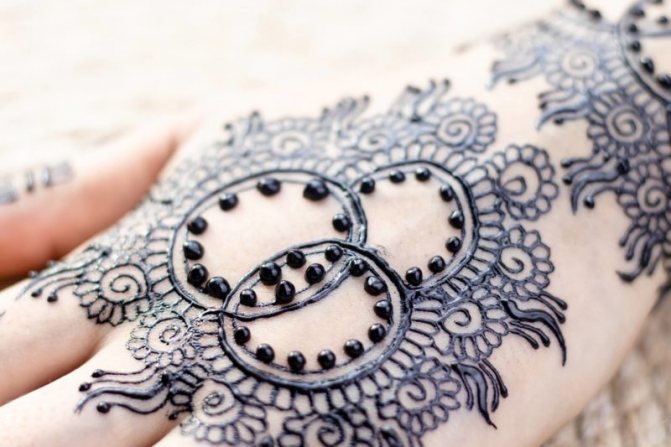

These instructions are suitable for implementation at home, as well as for manicurists who have decided to introduce a new service this spring.
Necessary materials and tools
- henna. You can prepare the paste yourself, but it is easier and better to buy ready-to-use henna for mehendi. It comes in small tubes with a narrowed spout. As an alternative, you can use jagua gel. This too is a natural dye made from fruit juice. Masters of painting say that it holds better and less likely to cause allergies. The color of the pattern will turn out dark blue-black;

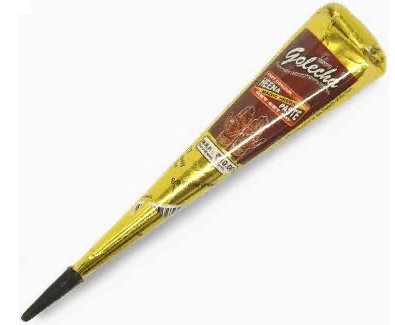
- oil. Oil is used to fix the pattern. You can use olive or coconut oil or special for mehendi painting. See examples of products at the end of the article;
- lint-free cloths For blotting the pattern;
- skin cleanser - Gel, lotion;
- antiseptic for disinfecting and preparing the skin for application;
- scrub for removal of keratinized particles from the area under the drawing;
- Stencil with the desired mehendi pattern.
Preparation stage
- Examine the area where the pattern will be located for any unwanted hairs. If there are, you need to depilate. First, the hairs will be colored with henna and will retain their color after the pattern is washed off. Second - the hairs prevent the paint from penetrating;
- Do an allergy test. Apply a small amount of paint to the bend of the elbow and wait 10-15 minutes. If there is no reaction, you can paint;
- Scrub your skin to remove dead particles, wipe it with a cleansing lotion and apply an antiseptic.
Painting
- Carefully peel the backing off the stencil. It is important to do it slowly, so that small elements do not tear and spoil the pattern;
- Tightly glue the stencil to the skin;
- Take off the protective film from the top, just, again, make sure that the small pieces don't stay on the film;
- Fill in the pattern with henna. The dye is applied in a thick layer - the thicker it is, the darker the pattern will be.
Final step.
- Wait for the paste to dry. This takes anywhere from 30 minutes to several hours, depending on the paste manufacturer and the thickness of the layer. For the exact time, see the instructions for the paint. You can determine the drying by the appearance of the henna - if the paint has begun to crumble and crack, then the stencil can be removed and the paint removed
- If you want to wear your mehendi for as long as possible, remove the paint with a spatula, the flat end of an orange stick or other handy materials. If the henna is washed off, the drawing will wear a little less;
- Use a cloth soaked in oil to dab the pattern to fix the result and make it richer.
The pattern will show its final color in the next 40 hours.
Manicure by feng shui: energy in the service of nail art
Sketches of mehendi on the hand for beginners
Sketches of mehendi on the hand for beginners
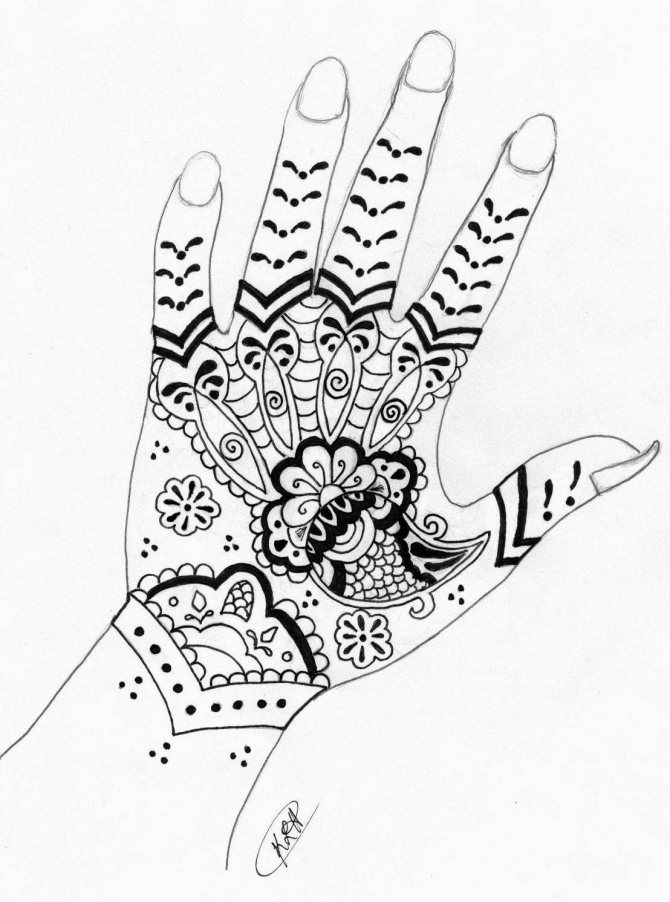

Sketches of mehendi on the hand for beginners Sketches of mehendi on the hand for beginners
Tips
Mishaps happen even to professionals during the drawing process. The mistake is not difficult to correct, if you have cotton swabs at hand, they can quickly remove a smudged or thick line. You can Remove excess paste with a toothpick.
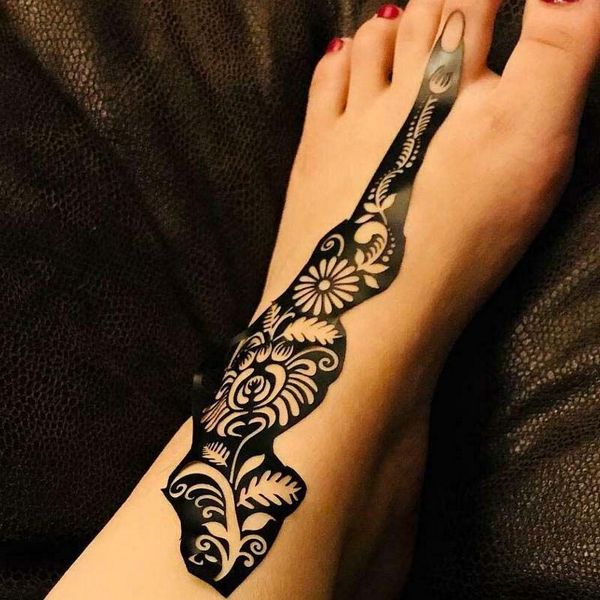

The stencil is glued tightly to the skin
Those who find it difficult to draw patterns, it is worth to buy mehendi stencils, they can be found in popular online stores, specialty stores, salons. Templates for beginners come in two types:
- disposable adhesive-based products made of stencil film, they are easy to stick, remove, do not cause skin irritation;
- reusable silicone products, they easily stick to the body, get the desired relief, after use they should be thoroughly washed and dried.
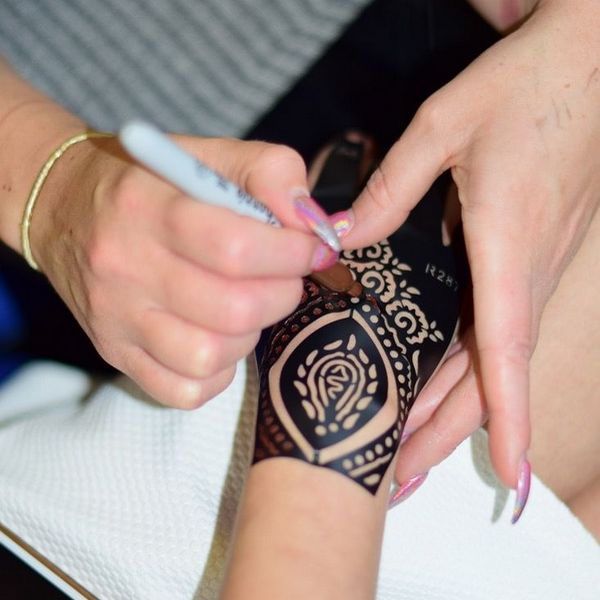

Mehendi on stencil
The stencil for mehendi can be made by yourself. To do it, find a sample on the Internet, print it out on a printer, transfer it to an elastic base and cut it out. Usually a self-adhesive film is used and the cuts for applying paint are made with a stationery knife.
Sketches mehendi on the leg for beginners
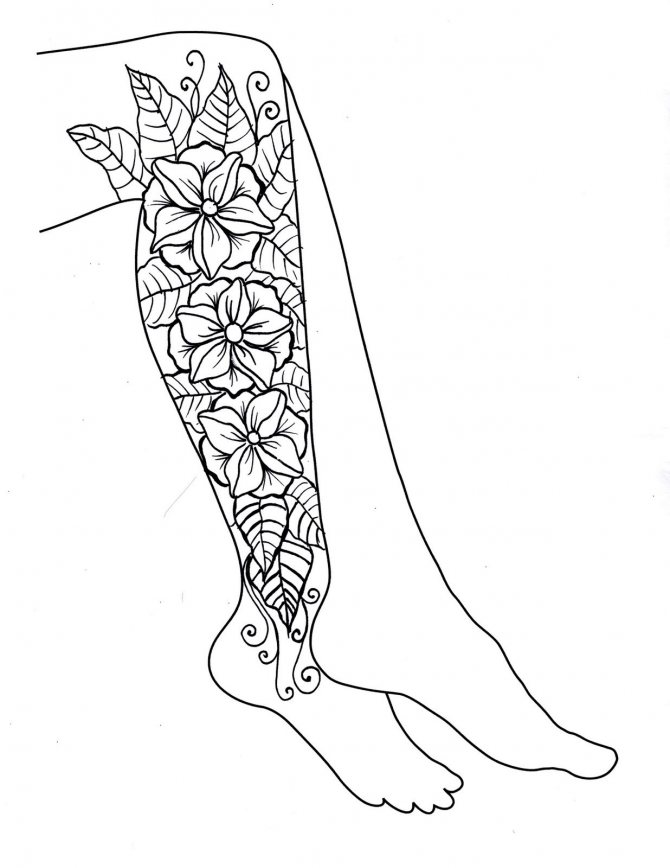

Sketches of mehendi on a leg for beginners Sketches of mehendi on a leg for beginners
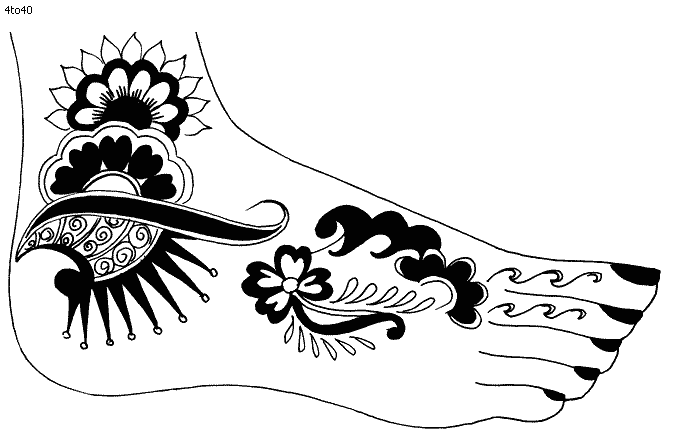

Sketches of mehendi on a leg for beginners
How to wash off a temporary tattoo?
On average, mehendi lasts about a month on your hands and then it completely disappears. If the drawing is not successful and you want to remove it beforehand, the procedure will take at least a week.
To get rid of the henna hand painting, you need to apply a scrub twice a day to the drawing and massage thoroughly for several minutes. Then rinse it off and apply a fat cream to the treated area. It will also not be superfluous to use lemon juice, which has a whitening effect. To do this, you need to squeeze it from one fruit and thoroughly rub it into the drawing, and then leave it as a mask for 15 minutes.
These are affordable ways to get rid of mehendi, there is no special remedy.
Hand stencils for mehendi
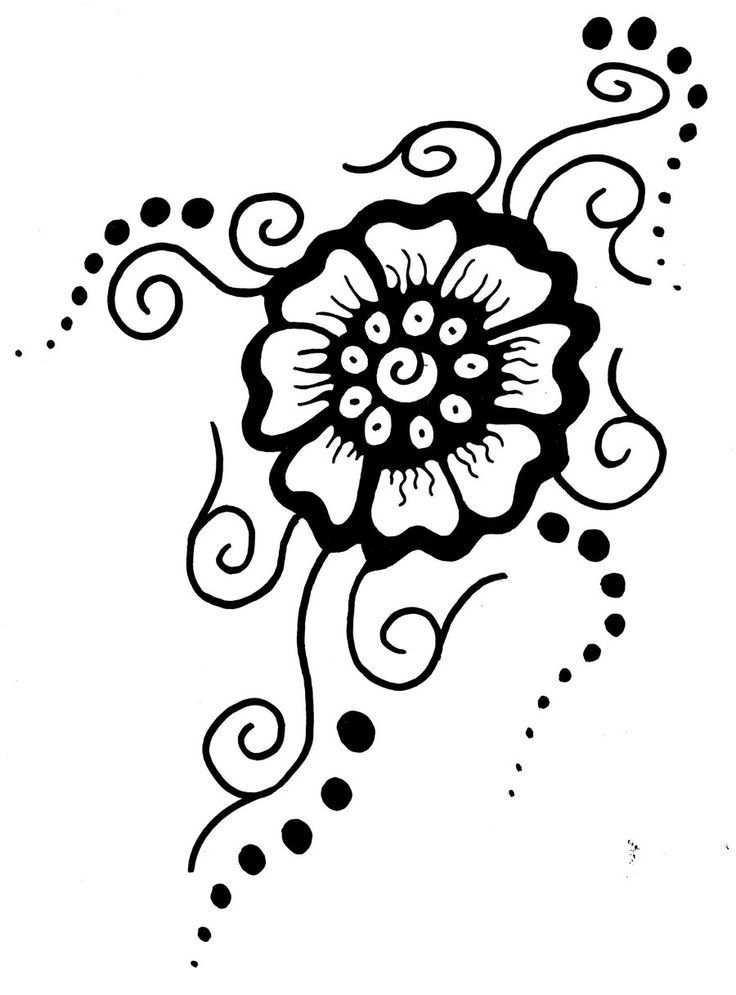

Stencils on the arm for mehendi Stencils on the arm for mehendi Stencils on the arm for mehendi
Home henna tattoo
In case you have not found a master in the application of such tattoos, you can do it yourself. Of course it will require a little practice so that the drawings are even and of the same thickness. It is also necessary to buy some materials for work.
It is best to buy a ready-to-use pattern compound. It can be in a tube or in a special cone. The latter option is the most convenient, because the henna from the cone comes out evenly. For beginners, this is an ideal option that will help you quickly learn how to make beautiful patterns.
If you have trouble finding a ready-made mixture, you can make it yourself. There are several recipes that differ from each other with additional ingredients. This does not affect the quality of henna, so choose any of them.
According to the first recipe, you need to mix about 20 grams of henna and the juice of half a lemon. This mixture should be insisted in a bag for one day. After that, you can add essential oil to make the pattern last longer, as well as ground coffee to make the mixture darker.
The second recipe is that the same amount of henna should be boiled in water for an hour. You can add black tea or coffee to brighten the color. The mixture should be cooled and only then try to apply drawings.


As for the application process, some masters suggest that beginners use special stencils. Thanks to this, the drawing will definitely have the right shape.
A beautiful henna tattoo is a whole art, thanks to which you can decorate the body and emphasize its merits. In addition, the process of drawing is absolutely painless, which is a significant advantage.
Have you tried doing a henna tattoo?
List of sources
- salon-nagorkogo.ru
- ratatum.com
- princessovna.ru
- lifegirl.ru
- costmart.ru
- wlooks.ru
Mehendi Leg Stencils
Stencils for mehendi Stencils for mehendi Stencils for mehendi Leg
To make a henna design
Before preparing your skin, it's also important to puzzle over how to properly do mehendi at home yourself. If you are a skilled artist with properly grown hands, the drawing process will not be too difficult for you. And what to do if you can draw, but are afraid that at the crucial moment your hand will shake?
There is a way out: after preparing your skin for the biotattoo, draw the desired pattern on it with a cosmetic pencil (eyebrow pencil, eye pencil, lip pencil - anything but waterproof) or with a water-based marker (as you understand, a permanent marker will not do Unless you have absolutely no henna *rofl* ). This way you can move confidently along the drawing, excluding mistakes, blots and other nuisances.
What if you can't draw at all? No, do not despair: there is a way out for you too, and you just like everyone else will be able to flaunt in boho style. Or any other style. Just for you there are detailed videos on how to paint henna on your arm, leg, and wherever you want. Or a miracle invention: stencils. You can buy them in mehendi salons, on specialized websites and Indian exhibitions, or even make them yourself (although it is quite time consuming and requires a certain skill).
Here are a few step by step video instructions:
The stencil can be attached to the skin with adhesive tape or scotch tape. Avoid "trapping" the stencil in the folds of the skin: the design will spread and lose its shape. Also take care not to accumulate too much paint on the borders of the stencil, because "too much" can disrupt the pattern, the smoothness of the lines and their thickness. If this happens, quickly erase the defect with a cotton swab or a thin match. The pattern is laid out with a paste a couple of millimeters thick (2-3).
This way it turns out thinner and more delicate. However, if it is thicker, the longevity and intensity of the pattern increases many times over. Here it is up to you to decide what is more important: the elegance of the lines or the longevity of the pattern.
Beautiful mehendi on hands and feet: photo
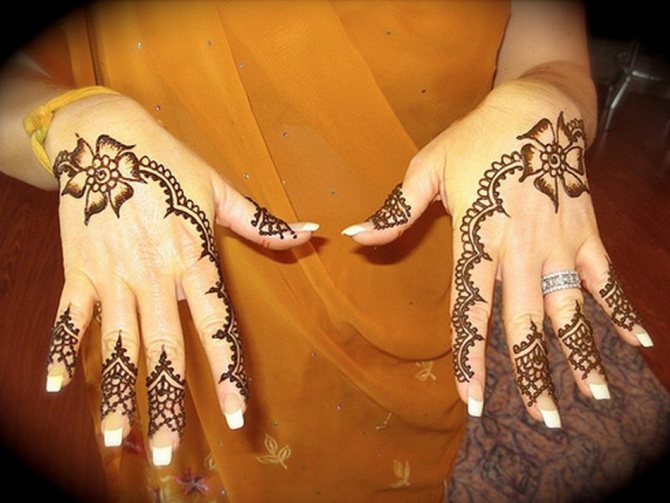

Beautiful mehendi on hands
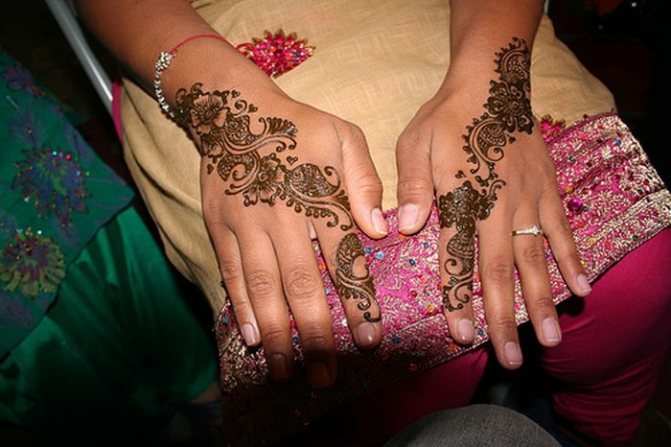

Beautiful mehendi on hands Beautiful mehendi on hands
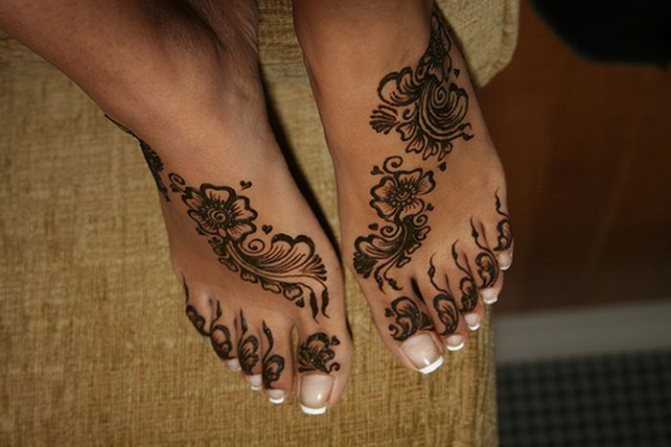

Beautiful mehendi on hands Beautiful mehendi on hands
Temporary Tattoo Mehendi: Reviews


Most women like a biotattoo done in the style of mehendi because it:
- temporary;
- beautiful and creative;
- absolutely harmless;
- good for the skin;
- quick to do;
- inexpensive;
- affordable;
- original at any time of the year;
- its procedure is painless;
- it is not annoying.
The only minus is a possible allergic reaction. But it can be checked by doing a test on the skin.
Surprise your family and friends by making an unusual pattern on the body. Having trained your hand, you will easily make more complicated ornaments. Passersby will stop their curious glances at you, and friends, perhaps, will ask them to paint some part of the body too. And you'll get fun and practice in one.
White mehendi on the arm: photo
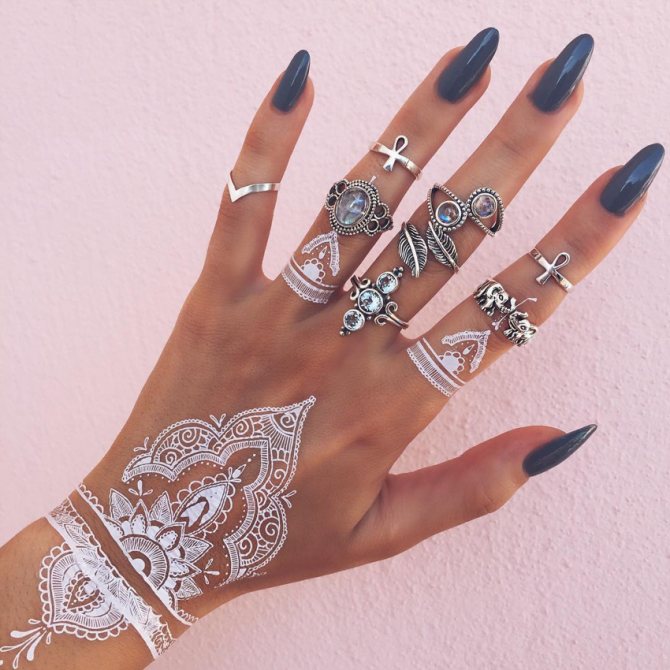

White mehendi on the arm White mehendi on the arm
White mehendi is made with a white acrylic paint called a glitter. This paint is made without using henna, because such a drawing will not last as long as a drawing made with henna.
Henna for drawing on the body - only a plus
The drawing procedure is absolutely painless, safe and quite pleasant, unlike the clasic tattoo. To quickly formalize the hands or feet you can use a stencil and apply henna from a tube, it is very convenient. Besides henna in tubes is fully prepared for painting. The consistency of the paint resembles thick sour cream. The only thing that can happen is an allergy to black henna, because there are paraphenylenediamines in the composition, which dye the reddish natural color into an ossine black color.
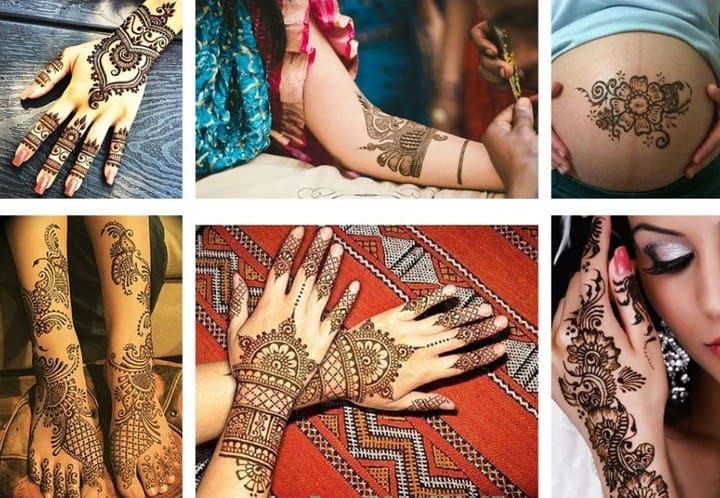

So my advice, if you are allergic, buy colorless henna and add activated charcoal to it. Undeniable benefits of mehendi:
- The body is protected from infections when applied, because there is no skin piercing;
- henna is temporary, each time you can change the pattern;
- drawing looks very aesthetic;
- henna is a natural antioxidant, so your skin under the drawing will breathe, be infused with beneficial substances and become softer.
If you look at how long your skin will hold a henna pattern, it's all individual. Skin cells are constantly renewing and the pattern will wear off, on average you will be able to enjoy the pattern for up to 2 weeks.
Indian henna order now
How long does mehendi last?
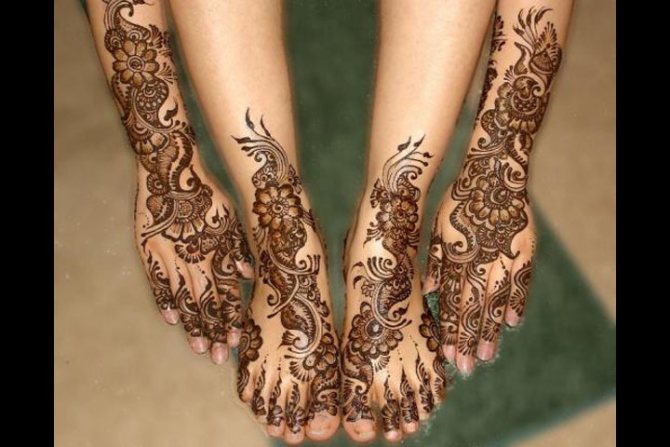

How long does mehendi last?
- If all recommendations are followed after the procedure, the mehendi can last at least two weeks. The maximum duration of a mehendi drawing is four weeks.
- In order to make the mehendi pattern last as long as possible, it must not be wet, scratched, rubbed or scrubbed for as long as possible
- If mehendi is made with glitter, it will last till the first contact with water, because acrylic paint does not penetrate into the skin, i.e. does not stain it.
Care of the pattern
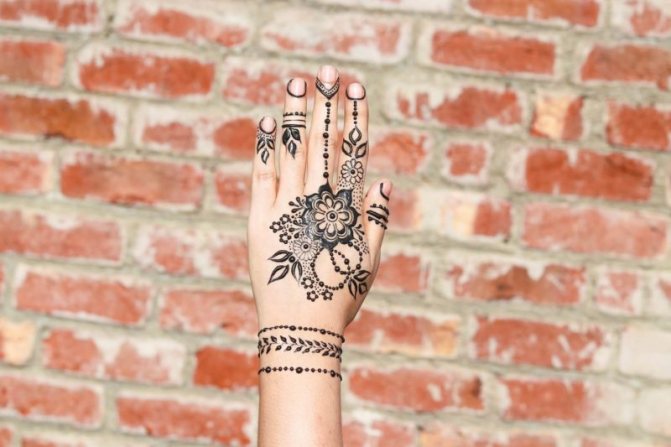

- After removing the glitter for 8-10 hours avoid contact with water, and try to minimize the exposure to moisture in the following days. Nothing will happen to the pattern from a trip to the shower, but several hours of swimming in the sea shortens the term of the wear. The list of "contraindications" also includes baths and saunas;
- Painting is susceptible to household chemicals. When painting on brushes - be sure to wear gloves when washing dishes or cleaning;
- Do not rub the painting with a washcloth.;
- Choose your skin care products carefully. Creams, lotions and tonics containing alcohol will quickly remove henna from your skin;
- moisturize your skin to slow down the formation of keratinized cells.. The detached scales break up the mehendi and make the pattern less pronounced;
- Do not use creams that have a bleaching effect.
Once the pattern begins to lose its brightness, it can be refreshed by filling in the old lines with henna or wait until it has finally come off and apply a new one.
How to erase mehendi?
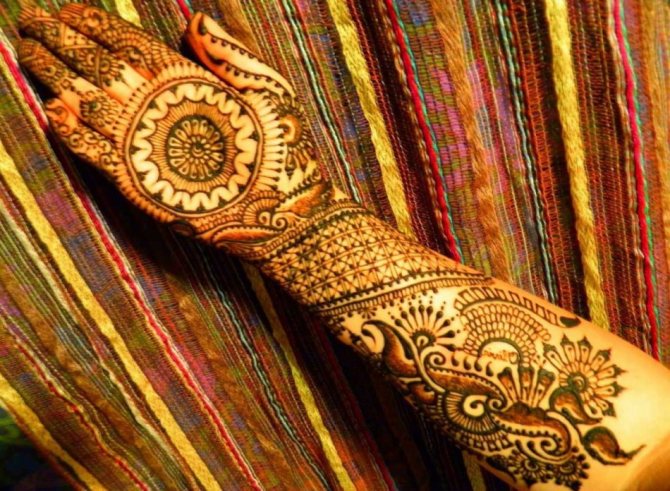

How to remove mehendi?
It is almost impossible to remove mehendi completely immediately after the procedure. But it is possible to weaken the color and blur the pattern. The following manipulations contribute to discoloration and removal of the drawing:
- going to the sauna
- Swimming in the bathtub and rubbing the spot with lemon juice
- vigorous rubbing of the mehendi spot with a sponge
- skin scrubbing
- rubbing the drawing area with alcohol
- wiping the drawing area with nail polish remover with acetone
- wiping the drawing with hydrogen peroxide
Tattoo henna: the main advantages
Despite the popularity of such temporary tattoos, many still doubt whether it is worth doing such a variant. In fact, this material has a lot of advantages. At a minimum, with its help, you can make absolutely any design on your own, even without turning to a master. This significantly saves time and finances.
In addition, it is impossible not to note that the application of the henna tattoo is absolutely painless, which can not be said about the classic version
The process of application itself is safe, which is also important. For many students and schoolchildren the indisputable advantage of course is the cost
It is ten times lower, so make such a tattoo can absolutely everyone.
Mehendi for men on the hand
Mehendi for men on the hand


Mehendi for men on the hand
The most ardent fans of the art of mehendi are women. They love to transform their bodies with such beautiful ornaments for different kinds of events, holiday trips, photo sessions and even weddings.
However, in addition to women, men can also decorate their bodies with beautiful drawings with semantic meaning. For them in the collection of mehendi there are also ornaments and patterns that emphasize their strength, courage, dignity and heroism.
The history of mehendi - when did they start painting henna on the body?
Its roots, mehendi, comes from Ancient Egypt. In those days, only noble women could paint their face, hands and feet with henna. A little later, this prerogative has spread to men. First the pharaohs, and then just the noble men began to generously decorate their bodies with unique patterns.
After a while, when henna became available, every Egyptian could afford the decoration. But drawing henna on the body in the ancient world was not just aesthetic in nature, but was closely linked to the belief in the afterlife. It was believed that in the afterlife, drawing will help to get peace, happiness and those benefits that were inaccessible to man on earth.
Gradually, the technique of body painting became popular in Asia, the East and Southern Africa. The coloring was brown and reddish, that's because the natural color of henna is red-brown. A little later, began to add ash, so you get a black color, seaweed, the artists already had at their disposal green and blue paint.


What does henna painting mean?
In every country, wearing mehendi means something different, in India, for example, it is believed that the more intricate drawing, the more experienced woman in the "affairs of love. In Muslims, only married women have the right to wear such drawings. In Morocco, pregnant women draw henna on their stomachs to protect them from the evil eye, and after giving birth on special tablets that are hung by the cradle.
In India and Thailand, they still stick to the tradition that until a young wife gets a drawing off her hands, she will not proceed to family duties and will not do anything at home (the honeymoon does not count), and the longer the mehendi remains on the body, the happier the family life will be.



